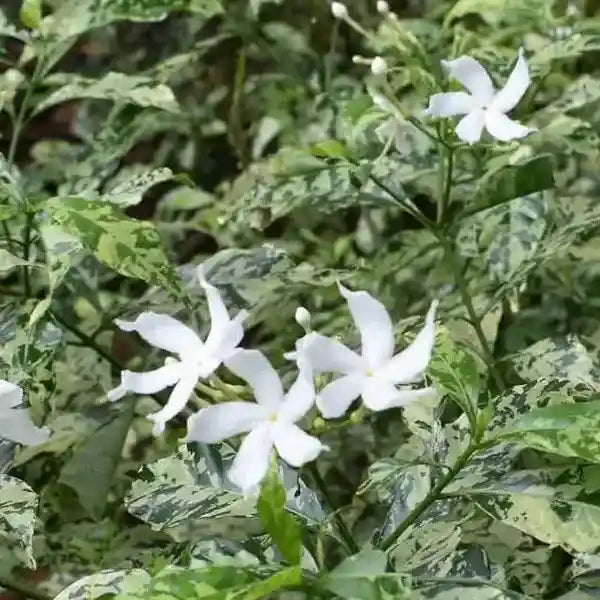
Pinwheel Jasmine Variegated
Selling Size : Single Plant | Pot Included | Secure Packing
The "Pinwheel Jasmine Variegated" is most commonly known as Variegated Crepe Jasmine or Tabernaemontana divaricata 'Variegata'. While it shares "Jasmine" in its common name due to its fragrant, pinwheel-shaped white flowers, it's actually not a true Jasmine (Jasminum species). It belongs to the family Apocynaceae, the same family as Plumeria (Frangipani).
The 'Variegata' cultivar is prized for its attractive foliage, which features a beautiful mix of green and creamy white or yellow variegation, in addition to its lovely flowers.
Here's a detailed guide to caring for your Pinwheel Jasmine Variegated:
1. Light:
Bright, Indirect to Partial Shade: This is the most crucial aspect for variegated plants. While the species Tabernaemontana divaricata can tolerate full sun, the variegated form benefits from bright, indirect light or partial shade, especially during the hottest part of the day.
Why: Direct, intense sun (especially in tropical India) can scorch the variegated parts of the leaves, turning them crispy brown. Too little light, however, can cause the variegation to fade and the plant to become leggy, with reduced flowering.
Ideal Placement: A spot that receives morning sun and afternoon shade, or bright filtered light throughout the day, is usually perfect. If growing indoors, an east or north-facing window is ideal.
2. Soil:
Well-Draining and Rich in Organic Matter: Excellent drainage is paramount to prevent root rot. The soil should be fertile and slightly acidic to neutral.
Recommended Mix: A good potting mix would include:
Garden soil or good quality potting mix
Plenty of well-rotted compost or farmyard manure (FYM)
Perlite, coarse sand, or coco peat to enhance drainage and aeration.
3. Watering:
Consistent Moisture, Not Soggy: Water regularly to keep the soil consistently moist, but never waterlogged.
"Finger Test": Allow the top 1-2 inches of soil to dry out before watering again.
Thorough Watering: Water deeply until water drains from the bottom of the pot. Ensure no standing water in the saucer.
Reduce in Cooler Months: In cooler weather or during the plant's slower growth period, reduce watering frequency to prevent root rot.
4. Humidity:
Moderate to High Humidity: Being a tropical plant, it appreciates good humidity.
Increase Humidity:
Mist regularly: Mist the foliage, especially during dry periods or if grown indoors.
Pebble tray: Place the pot on a tray filled with pebbles and water (ensure the pot is not sitting directly in the water).
Humidifier: In very dry indoor environments, a room humidifier can be beneficial.
5. Temperature:
Warm and Stable: Pinwheel Jasmine Variegated thrives in warm temperatures, ideally between 18∘C and 30∘C (65∘F and 86∘F).
Protect from Cold: It is not frost-tolerant. If temperatures drop below 10∘C (50∘F), the plant can suffer damage. In cooler climates, grow it in a pot that can be moved indoors during winter.
Avoid Drafts: Protect it from sudden temperature fluctuations or cold drafts.
6. Fertilization:
During Growing Season (Spring to Autumn): Fertilize every 4-6 weeks with a balanced liquid fertilizer (e.g., NPK 10-10-10 or 20-20-20) diluted to half strength.
For Enhanced Blooms: Once buds start to appear, you can switch to a fertilizer higher in phosphorus to promote more abundant flowering.
Organic Options: Incorporate well-rotted compost or neem cake into the soil periodically.
Reduce/Stop in Winter: Do not fertilize during the cooler, dormant months.
7. Pruning:
Maintain Shape and Encourage Bushiness: This plant benefits from regular light pruning to maintain a compact, bushy shape and encourage more branching, which leads to more flowers.
Deadhead: Remove spent flowers to encourage continuous blooming.
Remove Damaged/Dead Growth: Snip off any dead, diseased, or yellowing leaves and stems immediately.
Major Pruning: A more substantial prune can be done after the main flowering season to shape the plant and remove any overgrown branches.
8. Repotting:
When Rootbound: Repot your Pinwheel Jasmine Variegated every 1-2 years or when you notice it becoming rootbound (roots circling the pot or growing out of drainage holes).
Pot Size: Choose a pot that is only slightly larger than the previous one.
9. Pests and Diseases:
Common Pests: Generally, it's a relatively pest-resistant plant, but occasionally, it can be affected by common houseplant pests like spider mites, mealybugs, or aphids.
Control: Inspect regularly. For minor infestations, wipe them off with a damp cloth or spray with a strong jet of water. For more persistent issues, use neem oil spray or insecticidal soap.
Diseases: The most common disease concern is root rot, which is almost always due to overwatering or poor drainage. Ensure your watering practices are correct and the soil drains well. Fungal leaf spots can occur in very humid conditions with poor air circulation.
Important Considerations:
Toxicity: Like many plants in the Apocynaceae family, Tabernaemontana divaricata contains milky sap that can be irritating and is considered toxic if ingested. Keep it away from pets and children.
Scent: The flowers have a mild, sweet fragrance, often more noticeable in the evening.
Growth Habit: It typically grows as a compact shrub, usually 3-6 feet tall and wide, making it suitable for hedges, borders, or container planting.
By providing the right balance of light, water, and nutrients, your Variegated Pinwheel Jasmine will be a stunning addition to your garden or home with its beautiful foliage and charming flowers.

